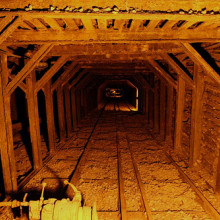This week news broke that Turkey had suffered its worst ever mining disaster after an explosion and fire in a mine in Soma claimed almost three hundred lives. But why are explosions such a risk when mining? Dave Ansell and Kate Lamble have your Quick Fire Science
In this episode

00:00 - Coal Mining Dangers
Coal Mining Dangers
This week news broke that Turkey had suffered its worst ever mining disaster after an explosion and fire in a mine in Soma claimed almost three hundred lives.
an explosion and fire in a mine in Soma claimed almost three hundred lives.
But why are explosions such a risk when mining? Here's your Quick Fire Science
- Coal is produced when organic matter, normally plants from swamps or forests, gets buried and then squashed and heated over millions of years
- This causes the organic matter to break down. Gaseous elements like hydrogen and oxygen are driven off, leaving the carbon which forms coal
- These gasses can be trapped in pockets in the coal, but millions of years later, as the mining process splits the rocks apart gases can be released once again.
- Gases can include carbon-dioxide, the poisonous gas hydrogen sulfide, and methane, also known as natural gas, which can explode when mixed with air.
- Methane used to be known as firedamp and was particularly dangerous for miners in the 18th and early 19th centuries when the only source of light was from candles which could ignite the gas.
- Miners used to use canaries and other small birds to detect asphyxiating and poisonous gasses as they would succumb before humans, but methane could reach explosive levels without affecting a canary.
- To solve this problem the British Chemist Sir Humphrey Davey invented a safety lamp after he discovered that a flame wouldn't pass through a fine metal grill. This meant it was possible to burn a candle in a metal gauze tube without igniting any gas outside.
- Davey also found that the flame would change colour and shape depending on gasses in the atmosphere.
- Even the coal itself can be dangerous to miners, because if coal dust is fine enough it will burn very quickly and effectively explode.
- Any explosions in mines can also make the environment more difficult for humans to breathe because the limited oxygen is consumed
- Even more dangerous is the carbon-monoxide produced by burning fuel with limited oxygen, as this binds to the haemoglobin in red blood cells and prevents your blood transporting oxygen.
- In the US over 3200 people were killed coal mining in 1907 to produce about 2 billion tonnes of coal
- However electric light, ventilation, gas sensors, and modern safety equipment has made coal mining far safer than it once was. So in the US in 2012 only 35 people were killed to produce about 600 million tonnes.
- However the safety record in other countries has some catching up to do, in the same year in China over 1300 people were killed mining 2.8 billion tonnes of coal.









Comments
Add a comment